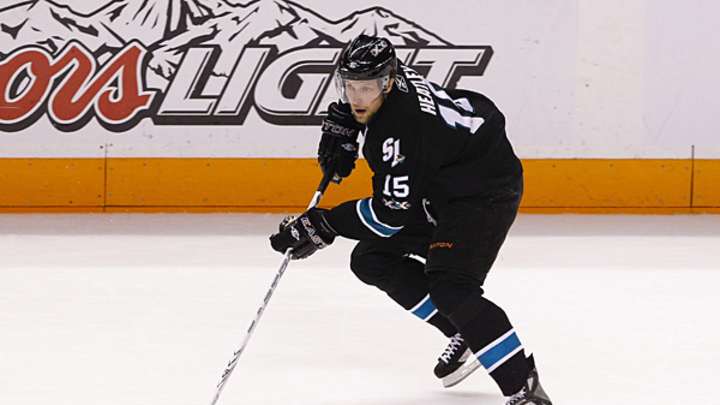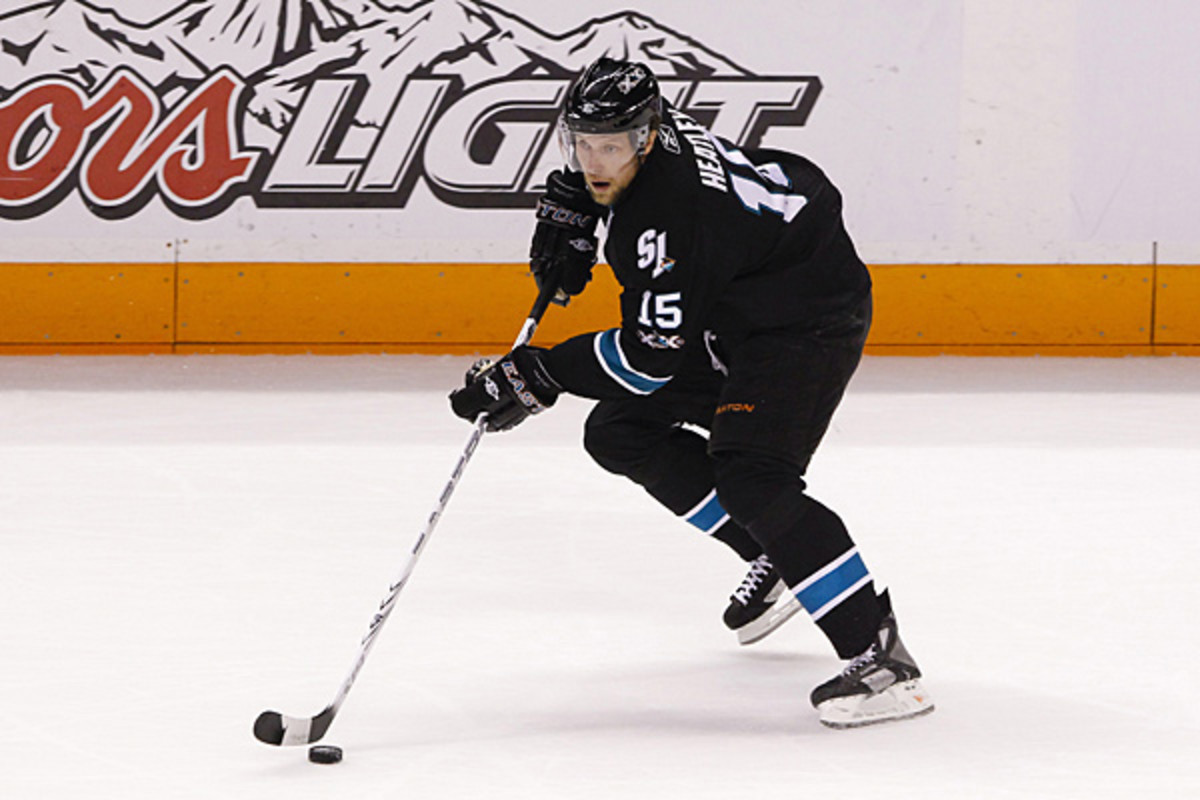The NHL's biggest gambles

Hoping for an offensive boost, the Wild are hoping that Dany Heatley's 26 goals and apparent lack of speed last season were a mere blip in his otherwise productive career. (Jason O. Watson/US PRESSWIRE)

By Stu Hackel
The moves -- and non-moves -- that NHL teams have made for the upcoming season can leave one either jubilant or very puzzled. We looked at a few that we called "science experiments" in early July and it has indeed been a wild summer of roster movement. There are few sure things in the world (hey, if you want a guarantee, buy a washing machine) and here are nine situations that might be considered some of the biggest gambles in the league. As with our looks at rookies last week (here and here), these are not in any particular order and not intended to be a definitive list. Just some thoughts as we head toward training camp.
The Avalanche's goaltending depth chart -- Semyon Varlamov, Jean-Sebastien Giguere and rookie Cedrick Desjardins -- is as big a risk as you'll find. Varlamov can at times play well, but he's injury prone and inconsistent, Giguere seems well past his prime and needs a strong defense corps to cover up the holes in his game. Desjardins, who played well in two games for the Lightning last season, had offseason shoulder surgery and, at last report, might miss training camp and will need time to recapture his game. If they are on top of their games, Varly and Giggy would be an interesting tandem, but no one has seen their best in a while. That they'll recapture the ability to do what they once could is what the Avs are banking on.
The Flyers' season hinges on a couple of things. One is in net, where they hope that Ilya Bryzgalov answers their chronic need for top-flight goaltending. Another risk is that banged-up Chris Pronger's health and form will return and he'll deliver the punishing, shutdown defense for which he's known. But Philly's biggest venture is up front and it resides first on Jaromir Jagr. The Flyers dealt away two impact forwards in Jeff Carter and Mike Richards, so the only guy one could say might, perhaps, maybe, possibly have some potential impact -- if all goes well -- is Jagr, who hasn't been an impact player in the NHL since 2007-08. They hope James van Riemsdyk's postseason play signaled that he's come of age -- he was rewarded with a six-year contract extension today -- and that they've replaced what they got from Ville Leino, but unless production comes from some unexpected source, like Jakub Voracek, Jagr's play is going to be crucial.
The Blue Jackets made two big offseason pickups in Jeff Carter and James Wisniewski and both have an element of uncertainty about them. Carter was upset to be to moved from Philly, and he went into hiding for a short time after the deal. He admitted his shock when he met the local media in July, but says he's excited with the move now -- and Columbus fans hope he truly is because he's the center the team has long sought to partner with Rick Nash, even though Carter played more as a winger for the Flyers. As for Wisniewski, he's getting huge money -- and the huge expectations that go with it -- to run the power play and be a top blueliner. Unlike Carter, whose big challenge might be mental and emotional, Wiz has never been considered a top D-man and, apart from a strong shot from the point, he doesn't really have the size and has not often shown the defensive acumen usually associated with first pair blueliner. Has he been a hidden gem all these years? That's the Jackets' hope...and maybe their biggest gamble.
The Sabresopened new owner Terry Pegula's bank vault this offseason and focused especially on building their blueline. They traded for Robin Regehr, who has two years left on his deal, and signed Christian Ehrhoff until 2021 so they could provide some veteran presence for relative youngsters like Tyler Myers and Marc-Andre Gragnani. But there are some who believe that Regehr's effectiveness as a top shutdown d-man has diminished and, as the Bruins showed in the Stanley Cup Final, Ehrhoff can have trouble containing big, hard-charging forwards, of which there are a few in Buffalo's division and conference. The Sabres were mid-pack in the East in goals-against, and their goaltending is set with Ryan Miller and Jhonas Enroth, but they are betting that their new blueline additions can do their part to improve the goals-against column.
The Wild hope to address, in part, their habitual lack of scoring with the addition of Dany Heatley from the Sharks. He's been a big-name offensive threat since his Calder Trophy season of 2001-02, averaging better than a point per game during his nine-year NHL career, but his numbers tailed off last season and he was often invisible in the postseason, which San Jose attributed to an injured hand. He's only 30 and Minnesota hopes last season was a one-year blip, but there's some thought that Heatley has lost foot speed (he was never the strongest skater anyway) and that greatly inhibits his play in the league's ever-increasing pace. A return to his 40-50 goal pace would provide the Wild with a crucial boost, but if last year's 26 is his new threshold, Heatley's going to disappoint the folks in the Twin Cities.
The Sharks hope to address their lack of quality depth on defense with the import of Brent Burns from the Wild. A great skater and athlete, Burns, 26, is an all-around talent who could be just coming into his own. He's been working to polish his game after some early seasons of inconsistent play and questionable decision-making. He's also had some injury issues, including a pair of concussions within months of each other in 2009. Like all concussion victims, he's more vulnerable now, and that's one reason why some eyebrows were raised when the Sharks extended his contract for five years after they acquired him in exchange for Devin Setoguchi, collegiate prospect Charlie Coyle, and a draft pick that the Wild turned into Zach Phillips. That's a lot to surrender, but it may be worth it if Burns plays up to projections. His continued development and health will reveal if the Sharks made a wise choice.
The Canadiens, taking risks in two areas, first hope that they've answered their need for scoring and size up front with the signing of UFA Erik Cole. Some believe that only the talents of Eric Staal could get the best out of Cole, which is why he only seemed to thrive as a member of the Hurricanes. Will the baffling Scott Gomez be able to create chances for Cole the way Staal did, and maybe rekindle his own career? Second, the strength of all Jacques Martin teams starts with defense, and the Canadiens lost both Andrei Markov and Josh Gorges, their best veteran blueliners, last season due to knee operations. Both are back, but the Habs lost some of blueline depth with the departures of James Wisniewski, Roman Hamrlik, Brent Sopel and Paul Mara. Other than signing UFA depth defender Jeff Woywitka, Montreal decided not to replace its losses with other veterans, but tap into the organization instead. That means the Habs will need healthy bounce-back campaigns from both Markov (who has had season-ending knee surgeries two years running) and Gorges in order to make a strong showing in the East.
The Flames, like the Blue Jackets with Rick Nash, have long sought a big-time center to work with Jarome Iginla. Veteran Brendan Morrison did a good job last season and, with Alex Tanguay, helped Calgary make a decent run at the postseason after a dismal start. Morrison's two-way play stood out, but his ACL injury in March short-circuited the team's run. The Flames eventually placed 22-year-old Mikael Backlund between Iggy and Tanguay and liked the results. They're penciling Backlund in to start there this season as Morrison continues his recovery (he's not expected to be 100 percent for training camp), but it's a bit of a risk considering that Backlund has only one full season of NHL experience and may not yet have all the tools needed for the job. With great hands and instincts, he is projected as a surefire first liner, and it's just a question of whether the Flames are rushing him or he's ready for prime time.
The Rangers, shedding their long-standing reputation for filling their roster with over-priced, underperforming free agents, may have gone too far the other way on their blueline. The organization's top seven defensemen -- Marc Staal, Dan Girardi, Ryan McDonagh, Michael Sauer, rookie Tim Erixon, Steve Eminger and Michael Del Zotto -- average 23-1/2 years of age and 191 games (less than two-and-a-half full seasons) of NHL experience. They consider Staal an emerging All-Star, sophomore McDonagh might turn out to be even better, and most of the others have good upside potential. But none is an elite offensive defenseman. (Brad Richards may QB the power play; Del Zotto has been an adventure.) Fora team that wants to start making the big push upward in the East, the Rangers may, as a group, lack the poise and consistency for that task. There's no stabilizing veteran in the mix -- rookie Erixon seems like the lone addition -- so they're rolling the dice on these guys being able to make the next step.
